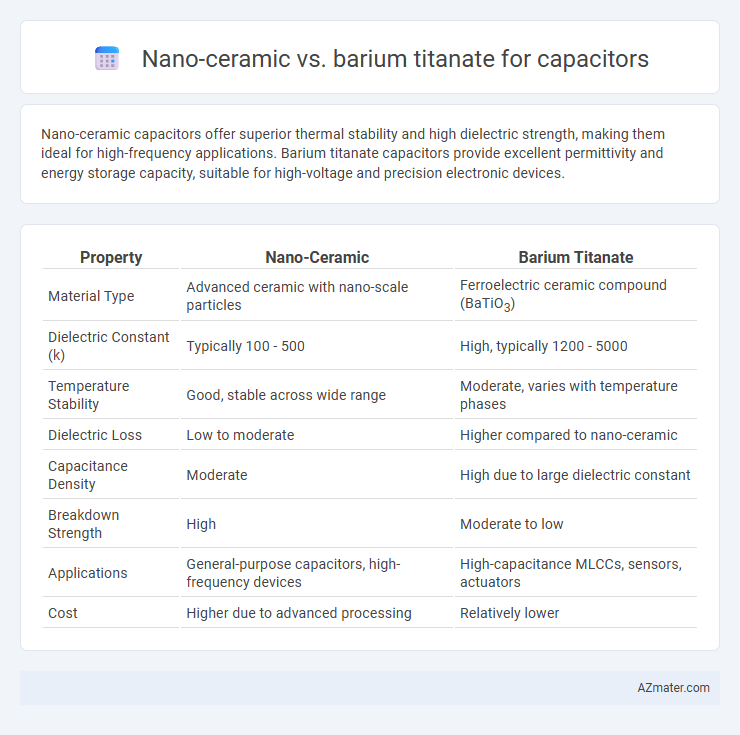Nano-ceramic capacitors offer superior thermal stability and high dielectric strength, making them ideal for high-frequency applications. Barium titanate capacitors provide excellent permittivity and energy storage capacity, suitable for high-voltage and precision electronic devices.
Table of Comparison
| Property | Nano-Ceramic | Barium Titanate |
|---|---|---|
| Material Type | Advanced ceramic with nano-scale particles | Ferroelectric ceramic compound (BaTiO3) |
| Dielectric Constant (k) | Typically 100 - 500 | High, typically 1200 - 5000 |
| Temperature Stability | Good, stable across wide range | Moderate, varies with temperature phases |
| Dielectric Loss | Low to moderate | Higher compared to nano-ceramic |
| Capacitance Density | Moderate | High due to large dielectric constant |
| Breakdown Strength | High | Moderate to low |
| Applications | General-purpose capacitors, high-frequency devices | High-capacitance MLCCs, sensors, actuators |
| Cost | Higher due to advanced processing | Relatively lower |
Introduction to Capacitor Dielectrics
Nano-ceramic and barium titanate are key materials used as dielectrics in capacitors, affecting their performance characteristics such as permittivity and temperature stability. Barium titanate, a ferroelectric material, offers high dielectric constant and excellent energy storage capacity, making it ideal for high-capacitance multilayer ceramic capacitors (MLCCs). Nano-ceramic dielectrics leverage nanoparticle engineering to enhance breakdown voltage and reduce dielectric losses, improving capacitor efficiency and reliability in miniaturized electronic devices.
Overview of Nano-ceramic Materials
Nano-ceramic materials in capacitors exhibit superior dielectric properties due to their nanoscale grain size, which enhances polarization and reduces dielectric loss compared to traditional barium titanate. These materials provide improved temperature stability and higher breakdown strength, making them ideal for miniaturized electronic components. The intrinsic nanoscale structure allows for greater energy density and faster charge-discharge cycles, positioning nano-ceramics as a promising alternative to barium titanate in advanced capacitor applications.
Understanding Barium Titanate Properties
Barium titanate, a ferroelectric ceramic material with a perovskite crystal structure, exhibits a high dielectric constant and excellent piezoelectric properties, making it ideal for capacitor applications requiring high capacitance and stability. Its ability to maintain performance under varying temperature and electric field conditions surpasses many nano-ceramic materials, optimizing energy storage and dielectric response. These intrinsic properties, including low dielectric loss and high permittivity, position barium titanate as a superior choice for high-performance capacitors.
Dielectric Constant Comparison
Nano-ceramic capacitors typically use dielectric materials with a dielectric constant ranging from 100 to 10,000, while barium titanate, a widely used ferroelectric ceramic, exhibits a dielectric constant between 1,000 and 7,000 depending on its microstructure and temperature. The higher dielectric constant of barium titanate enhances the capacitance density, making it suitable for applications requiring compact, high-capacitance components. In contrast, nano-ceramics offer tunable dielectric properties through particle size optimization, enabling precise control over performance characteristics in advanced capacitor designs.
Performance in High-Frequency Applications
Nano-ceramic capacitors exhibit superior high-frequency performance due to their low equivalent series resistance (ESR) and enhanced dielectric stability, enabling efficient signal integrity and minimal energy loss at GHz ranges. Barium titanate capacitors offer high dielectric constant and capacitance density but encounter increased dielectric losses and reduced Q-factor under high-frequency conditions, limiting their efficiency in RF circuits. The nano-ceramic material's tailored grain size and microstructure optimize polarization mechanisms, making it preferred for applications like 5G communication and high-speed signal processing.
Temperature Stability and Reliability
Nano-ceramic capacitors offer superior temperature stability due to their tightly controlled nanostructure, maintaining consistent capacitance across wide temperature ranges from -55degC to 125degC. Barium titanate capacitors, while exhibiting high dielectric constant, suffer from significant temperature-induced dielectric constant variations and phase transitions near 120degC, which compromises reliability in thermal cycling applications. The enhanced reliability of nano-ceramic capacitors under thermal stress makes them preferable in environments demanding long-term performance stability.
Miniaturization and Capacitance Density
Nano-ceramic capacitors exhibit superior miniaturization capabilities due to their high dielectric constant and enhanced grain boundary engineering, enabling significant capacitance density at reduced volumes. Barium titanate, a perovskite ceramic with a high dielectric constant, provides excellent capacitance density but often requires larger sizes to maintain stability and performance under varying temperature conditions. Advances in nano-ceramic formulations optimize the microstructure for higher permittivity and lower dielectric loss, making them preferable for compact, high-capacitance applications compared to traditional barium titanate capacitors.
Manufacturing and Cost Considerations
Nano-ceramic capacitors offer superior dielectric properties and high-temperature stability due to their nanoscale grain structure, enabling thinner layers and higher capacitance in compact designs. Barium titanate capacitors, widely used for their high permittivity and reliable ferroelectric characteristics, require more complex sintering processes and strict temperature controls, leading to higher manufacturing costs. The cost efficiency of nano-ceramic capacitors arises from simplified processing techniques and reduced material usage, making them increasingly favorable for high-volume production.
Environmental and Safety Impact
Nano-ceramic capacitors generally pose lower environmental and safety risks due to their stable chemical composition and non-toxic materials, minimizing hazardous waste during manufacturing and disposal. In contrast, barium titanate capacitors contain heavy metals like barium, which can be toxic and require careful handling to prevent environmental contamination and health hazards. Proper recycling and disposal protocols are essential for barium titanate components to mitigate their ecological and safety impacts effectively.
Future Trends in Capacitor Dielectrics
Nano-ceramic dielectrics exhibit superior breakdown strength and thermal stability compared to traditional Barium titanate, driving their adoption in next-generation capacitors. Advances in nanostructuring and doping techniques further enhance dielectric constant and energy density, positioning nano-ceramic materials as critical for future high-performance capacitors. Research trends emphasize integrating nano-ceramics with flexible substrates to meet growing demands in wearable electronics and electric vehicles.

Infographic: Nano-ceramic vs Barium titanate for Capacitor
 azmater.com
azmater.com